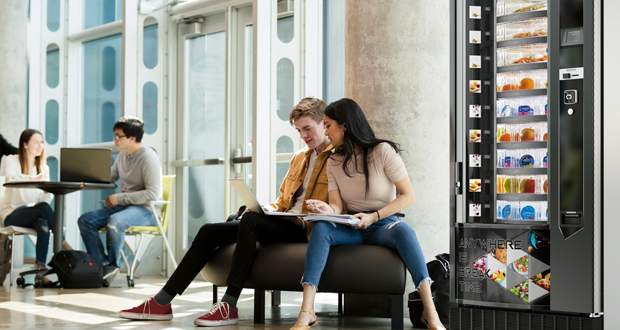Ian Reynolds-Young, the Editor of Planet Vending gives us the insiders view on how the latest technologies are helping the vending sector deliver workplace foodservice in a myriad of ways
While FMJ is aware of a current trend that sees more FM readers relying on vending to supplement their catering offers, my perspective comes from the other side of the fence, and I can confirm that the vending industry is not simply buoyant just now; it is relishing the future with a confidence seldom seen before.
What we’re seeing in workplace right now is not a ‘trend’, it’s part of a phenomenon that is sweeping through every aspect of retail, foodservice and hospitality: ‘unattended retail’.
AVA RESEARCH
New research from the The Vending and Automated Retail Association, (the AVA), reports 16 per cent growth in the sector from 2020 to 2021. What’s more, the AVA states that operators expect further growth of 20 per cent in 2022, and while some of this can be attributed to price increases and the return to work, growth in the Coffee-to-Go market (up 20 per cent from 2020 to 2021), plus the unprecedented rise in the popularity of Micromarkets, (which saw a 25 per cent increase from 2020 to 2021), are set to continue as major contributors to the sector’s growth.
Nayax has morphed from being a provider of cashless payment, IoT service and management solutions into an award-winning payment and merchant account powerhouse that covers the globe, in fewer than 20 years. The company defines unattended retail as ‘taking simple vending solutions into a more technically-evolved landscape, where the focus is on innovation. Powered by technologies such as cashless payment systems, the Internet of Things and artificial intelligence / machine learning (AI/ML), unattended retail significantly expands the possibilities of what traditional vending can achieve.’
Nayax and other providers such as Vianet, Televend and Vendon offer solutions that integrate telemetry to provide operators with the data they need to hone every aspect of the service they offer.
Many lay the ‘credit’ for the status quo on the pandemic, but that’s only half true, as Jane McDonald, Managing Director of Excel Vending, (recently named ‘Best Overall Operator’ at the recent ‘Vendie’ Awards), is anxious to point out.
“Personally, I don’t think the effects of the pandemic dramatically changed things,” she said. “What it did was accelerate the adoption of innovative technologies such as touchless screens, contactless payments, own-cup scanning and micro-markets, which were already being rolled out before the emergency. But because of COVID, these features are now as seen by consumers as ‘essentials’, rather than ‘preferred options’.”
UNATTENDED RETAIL
Natalie Baker is Finance Director at Westways Vending, voted ‘Best Regional Operator’ at the same awards. “Vending has transitioned quickly into unattended retail, leading to faster innovation including media screens, loyalty payment apps and micro-markets”, she says.
“The rise in technology has meant that most vending machines can now report data back to the operator in real time, ensuring that the machines never run out of the food people love. Vending is therefore brilliantly placed to ensure ‘food on the go’ is available to all, 24 hours a day 7 days a week. The rise of cashless payments is as ever present in vending as it is in everyday life, so as an industry we embraced this change some time ago.”
365 International is the global leader in micromarkets and when I interviewed its President John Chidiac recently he told me that in the USA around 40 per cent of organisations with over 200 people have a MicroMarket on campus. That’s a huge number, but I replied “the implication is that unless you have the ‘magic’ 200 number, the benefits of automated retail are not for you.” I was wrong. 365, aware that the UK was a different beast, had developed a product called PicoMarket; a small, versatile stand-alone kiosk that can be placed in any type or size location. “It’s a self-service device that gives customers many grab-and-go opportunities and offers both cellular and hardline connectivity at a cost comparable to traditional vending”, Chidiac said. “It makes available the advantages of Automated Retail to a huge cohort of SMEs.”
 The key word for the industry as it moves ahead is ‘connectivity’, and this is reflected in the surge in the number of apps that allow consumers to use vending machines from their smart phones. Evoca, the world-leading coffee and vending machine company whose brand portfolio includes Gaggia, Necta and Saeco amongst others, has developed an app of its own. “CoffeeAPPeal brings the world of contactless technology and smartphone ordering to the office coffee machine”, Evoca UK Sales Director Craig Jukes said. “It uses a Bluetooth connection that works at up to a metre from the machine, so users don’t have to touch it to make their purchase.”
The key word for the industry as it moves ahead is ‘connectivity’, and this is reflected in the surge in the number of apps that allow consumers to use vending machines from their smart phones. Evoca, the world-leading coffee and vending machine company whose brand portfolio includes Gaggia, Necta and Saeco amongst others, has developed an app of its own. “CoffeeAPPeal brings the world of contactless technology and smartphone ordering to the office coffee machine”, Evoca UK Sales Director Craig Jukes said. “It uses a Bluetooth connection that works at up to a metre from the machine, so users don’t have to touch it to make their purchase.”
APPS INFLUENCE
Johnny Broderick is MD of both Pay4Vend and Broderick’s, the UK’s largest and most influential independent vending operator. He explains how the use of apps benefits the operator as much as the consumer… “By encouraging consumers to use an app to make their purchases, you’re not only giving them a convenient way to pay – you’re also opening the door to a whole world of promotion and reward, which gives you unprecedented insight on your customers: who they are, what they buy and when they buy it”, he said.
There are practical advantages, too: “If a vend fails, for whatever the reason, the consumer is credited immediately through the app.”, Johnny says. “This builds up trust and makes users more confident than ever to use a vending machine.” And of course, perhaps the greatest advantage of the technology: “Who wants to break into a machine with no money in it?” Johnny said.
Needless to say, the success of any retail operation, automated or otherwise, depends on satisfying consumer demand by offering products they want to buy. The best-selling products in vending machines post pandemic are pretty much the same as they were before, but Allan Walker, Operations Director at Automatic Retailing Northern, the industry’s pre-eminent wholesaler, has seen developments lately in soft drinks.
“We saw a massive increase in sales of energy drinks post pandemic”, he said. “I’m not sure what the driver is behind this growth but it’s showing no signs of abating.” Sales of bottled water have remained constant throughout the emergency, but Walker points out a new phenomenon that is having a significant impact on the marketplace: vitamin water. Two brands are making conspicuous headway: VITHIT and Get More. “When they first came out, vitamin drinks were a niche product that just a handful of customers got behind, but these days they are gaining traction at pace.”
Finally, having outlined the numerous advantages automated retail enjoys in the race to become the preferred choice of consumers, there’s another advantage incumbent in offering a service that is unattended…
Hiring staff these days is becoming a nightmare. There are evidently more jobs than there are people qualified to do them. Leading restaurants and other hospitality outlets are, in many cases, reducing menus – even cutting service periods completely.
Just a thought…





